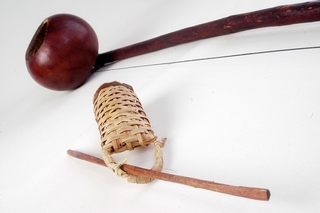Berimbau
Musical bow with resonator-vessel rattle (311.121.222-4 + 112.13). It is of African origin and its morphological and technical characteristics of performance resemble those of the Bantus musical bows from Angola.
Since the early 19th c , well informed and illustrated specialized writers have made known that this instrument was introduced and spread out in Brazil, especially by black slaves.
The berimbau consists of a rustic wooden stick with a wire string fastened at each end.
The resonator is made of three quarters of a gourd attached to the bow by a binding that also acts as a noose, dividing the string at about its sixth part. The longest segment is beaten with a little stick held in the right hand together with a caxixi, a small wickerwork rattle made of a wickerwoork. A coin, a metal piece or a pebble held by the right-hand thumb and index finger is placed on such segment to vary the pitch.
Timbre variations are achived as the player changes the distance between the resonator and his belly.
Nowadays the instrument is always present in the capoeira, gymnastic game that represents a fight among men. Since about twenty years ago it has been occasionally been played by Brazilian jazz groups and popular music.
L. 125 x w. 13.3 x h. of the berimbau 18 cm.
L. of the sticker 27.2 cm.
I L. 4 x w. 4.5 x h. of the caxixi14.5 cm.
I Gift, Cristina Fabre, 1980.
I Bought in Bahia, (Brazil), 1980. IM 635







